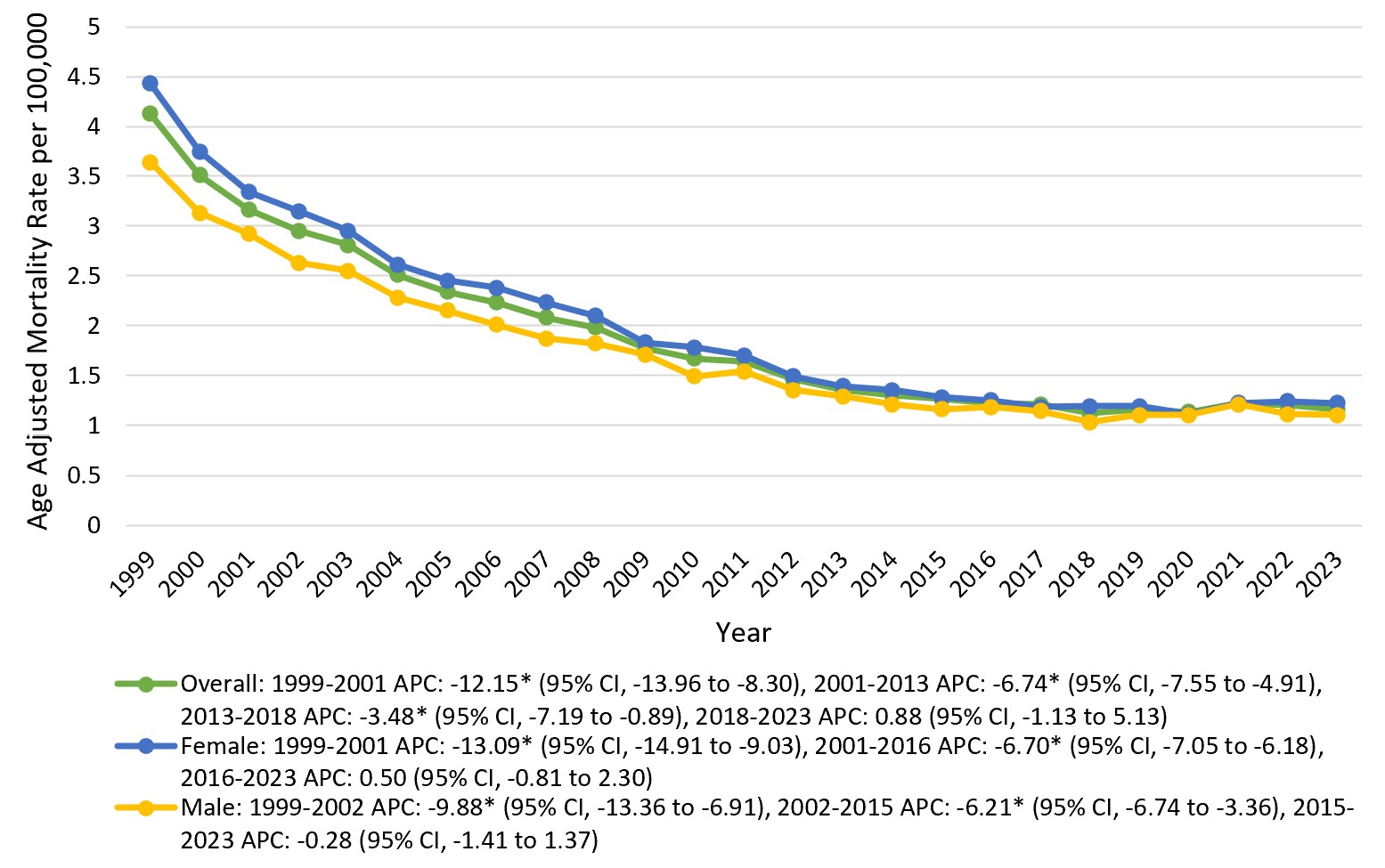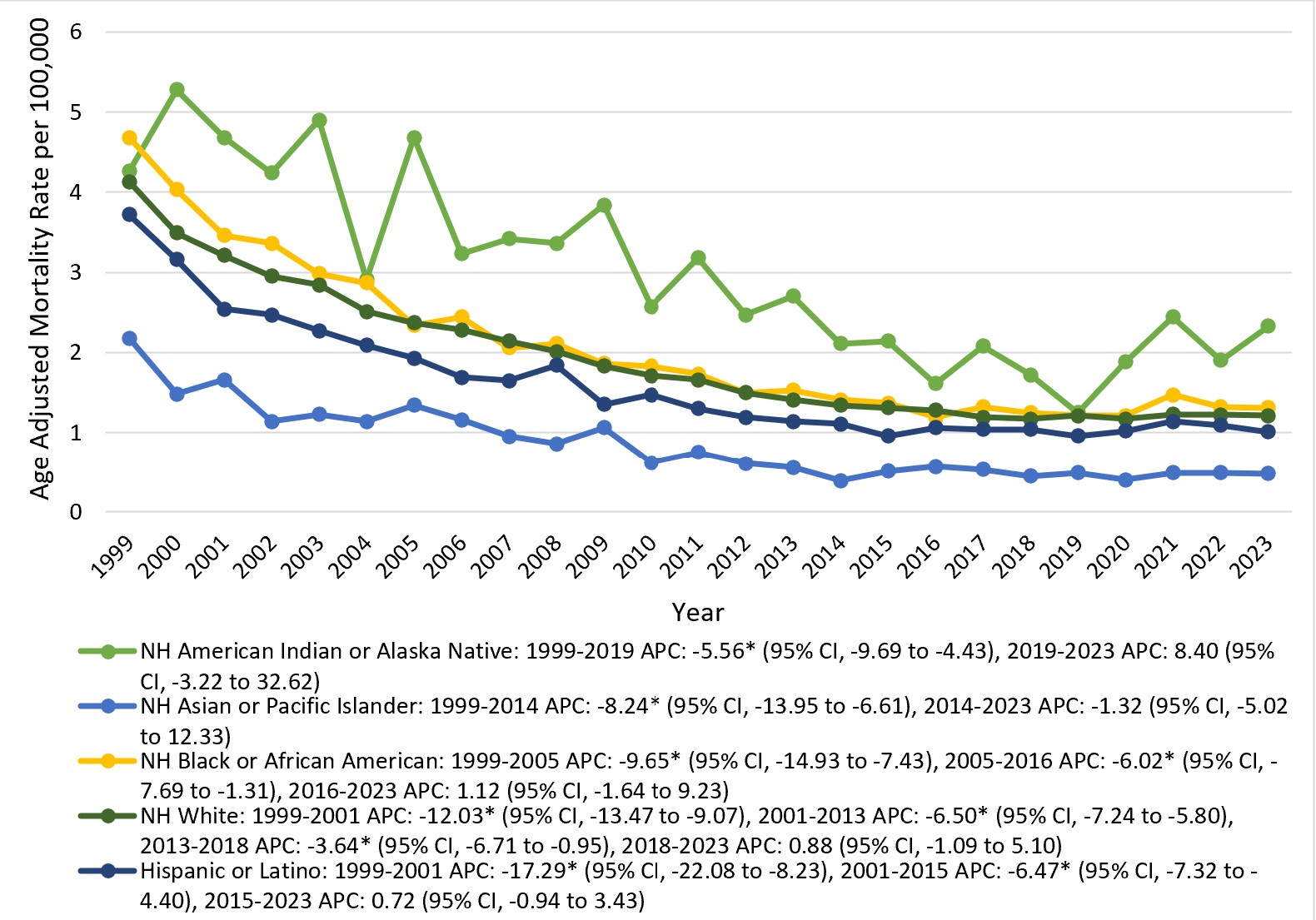Monday Poster Session
Category: Small Intestine
P4075 - Trends and Disparities in Acute Mesenteric Ischemia Mortality in the United States From 1999 to 2023: Insights From CDC WONDER
Monday, October 27, 2025
10:30 AM - 4:00 PM PDT
Location: Exhibit Hall
- RA
Rahila Ali, MD (she/her/hers)
Memorial Hospital at Gulfport
Gulfport, MS
Presenting Author(s)
Sadaf Iftikhar, MBBS1, Rahila Ali, MD2, Rizwana Noor, 3, Sweta Sahu, MBBS4, Muhammed Zulqarnain, MD5
1Akhtar Saeed Medical and dental college, Lahore, Punjab, Pakistan; 2Memorial Hospital at Gulfport, Gulfport, MS; 3Khyber Medical College, Peshawar, North-West Frontier, Pakistan; 4J.J.M. Medical College, Bhubaneswar, Orissa, India; 5University of Kentucky, Bowling Green, KY
Introduction: Acute mesenteric ischemia (AMI) is a sudden, life-threatening condition caused by abrupt reduction in blood flow to the intestines, leading to rapid ischemic injury and high mortality if not promptly treated. This study analyze AMI associated mortality trends among adults (≥25 years) in the United States from 1999 to 2023.
Methods: Data were extracted from CDC WONDER using ICD-10 code K55.0 for AMI. Crude and age-adjusted mortality rates (AAMRs) per 1,00,000 population were computed. Annual percent change (APC) and average annual percent change (AAPC) with 95% Confidence Intervals (CIs) were assessed using Joinpoint software.
Results: Between 1999 and 2023, 31,965 deaths were attributed to AMI mortality. The overall AAMR declined from 4.13 in 1999 to 1.16 in 2023, with an AAPC of -4.99 (95% CI: -5.25 to 4.73). An initial sharp decline occurred from 1999 to 2001 (APC: -12.15, 95% CI: -13.96 to -8.30), followed by a steady reduction through 2013 (APC: -6.74, 95% CI: -7.55 to -4.91) and 2018 (APC: -3.48, 95% CI: -7.19 to -0.89). From 2018 to 2023, mortality rates stabilized with no significant change (APC: 0.88, 95% CI: -1.13 to 5.13). While women had higher AAMR than men, the rate of decline was also more pronounced in women (AAPC: -5.22, 95% CI: -5.48 to -4.96) compared to men (AAPC: -4.75, 95% CI: -5.04 to -4.43). Non-Hispanic (NH) American Indian experienced the slowest decline (AAPC: -3.36, 95% CI: -4.94 to -2.23), while NH Asian showed the steepest reduction (AAPC: -5.71, 95% CI: -6.95 to -4.59).
Regionally, the West exhibited the slowest decline (AAPC: -4.83, 95% CI: -5.13 to -4.56), while the South had the most marked reduction (AAPC: -5.31, 95% CI: -5.61 to -5.04). Rural areas showed a higher AAMR (2.36) and a slower mortality decline (AAPC: -4.75, 95% CI: -5.25 to -4.30) compared to urban areas (AAMR: 1.31; AAPC: -6.15, 95% CI: -6.38 to -5.87). AAMR declines were more gradual in younger adults (25–44 years) (AAPC: -1.18, 95% CI: -2.13 to -0.26), compared to older adults (≥ 65 years) (AAPC: -5.64, 95% CI: -5.87 to -5.41). Most deaths occurred in medical facilities (90.44%).
Discussion: Between 1999 and 2023, mortality from AMI declined significantly; however, the pace of this decline has slowed in recent years. Notably, slower declines in men, NH American Indians, resident of the Western region, rural areas, and younger adults highlight ongoing disparities and the need for targeted interventions.

Figure: Figure 1. Acute mesenteric ischemia-associated age adjusted mortality rates per 100,000 stratified by the sex in the United States from 1999 to 2023.

Figure: Figure 2. Acute mesenteric ischemia-associated age adjusted mortality rates per 100,000 stratified by the race in the United States from 1999 to 2023.
Disclosures:
Sadaf Iftikhar indicated no relevant financial relationships.
Rahila Ali indicated no relevant financial relationships.
Rizwana Noor indicated no relevant financial relationships.
Sweta Sahu indicated no relevant financial relationships.
Muhammed Zulqarnain indicated no relevant financial relationships.
Sadaf Iftikhar, MBBS1, Rahila Ali, MD2, Rizwana Noor, 3, Sweta Sahu, MBBS4, Muhammed Zulqarnain, MD5. P4075 - Trends and Disparities in Acute Mesenteric Ischemia Mortality in the United States From 1999 to 2023: Insights From CDC WONDER, ACG 2025 Annual Scientific Meeting Abstracts. Phoenix, AZ: American College of Gastroenterology.
1Akhtar Saeed Medical and dental college, Lahore, Punjab, Pakistan; 2Memorial Hospital at Gulfport, Gulfport, MS; 3Khyber Medical College, Peshawar, North-West Frontier, Pakistan; 4J.J.M. Medical College, Bhubaneswar, Orissa, India; 5University of Kentucky, Bowling Green, KY
Introduction: Acute mesenteric ischemia (AMI) is a sudden, life-threatening condition caused by abrupt reduction in blood flow to the intestines, leading to rapid ischemic injury and high mortality if not promptly treated. This study analyze AMI associated mortality trends among adults (≥25 years) in the United States from 1999 to 2023.
Methods: Data were extracted from CDC WONDER using ICD-10 code K55.0 for AMI. Crude and age-adjusted mortality rates (AAMRs) per 1,00,000 population were computed. Annual percent change (APC) and average annual percent change (AAPC) with 95% Confidence Intervals (CIs) were assessed using Joinpoint software.
Results: Between 1999 and 2023, 31,965 deaths were attributed to AMI mortality. The overall AAMR declined from 4.13 in 1999 to 1.16 in 2023, with an AAPC of -4.99 (95% CI: -5.25 to 4.73). An initial sharp decline occurred from 1999 to 2001 (APC: -12.15, 95% CI: -13.96 to -8.30), followed by a steady reduction through 2013 (APC: -6.74, 95% CI: -7.55 to -4.91) and 2018 (APC: -3.48, 95% CI: -7.19 to -0.89). From 2018 to 2023, mortality rates stabilized with no significant change (APC: 0.88, 95% CI: -1.13 to 5.13). While women had higher AAMR than men, the rate of decline was also more pronounced in women (AAPC: -5.22, 95% CI: -5.48 to -4.96) compared to men (AAPC: -4.75, 95% CI: -5.04 to -4.43). Non-Hispanic (NH) American Indian experienced the slowest decline (AAPC: -3.36, 95% CI: -4.94 to -2.23), while NH Asian showed the steepest reduction (AAPC: -5.71, 95% CI: -6.95 to -4.59).
Regionally, the West exhibited the slowest decline (AAPC: -4.83, 95% CI: -5.13 to -4.56), while the South had the most marked reduction (AAPC: -5.31, 95% CI: -5.61 to -5.04). Rural areas showed a higher AAMR (2.36) and a slower mortality decline (AAPC: -4.75, 95% CI: -5.25 to -4.30) compared to urban areas (AAMR: 1.31; AAPC: -6.15, 95% CI: -6.38 to -5.87). AAMR declines were more gradual in younger adults (25–44 years) (AAPC: -1.18, 95% CI: -2.13 to -0.26), compared to older adults (≥ 65 years) (AAPC: -5.64, 95% CI: -5.87 to -5.41). Most deaths occurred in medical facilities (90.44%).
Discussion: Between 1999 and 2023, mortality from AMI declined significantly; however, the pace of this decline has slowed in recent years. Notably, slower declines in men, NH American Indians, resident of the Western region, rural areas, and younger adults highlight ongoing disparities and the need for targeted interventions.

Figure: Figure 1. Acute mesenteric ischemia-associated age adjusted mortality rates per 100,000 stratified by the sex in the United States from 1999 to 2023.

Figure: Figure 2. Acute mesenteric ischemia-associated age adjusted mortality rates per 100,000 stratified by the race in the United States from 1999 to 2023.
Disclosures:
Sadaf Iftikhar indicated no relevant financial relationships.
Rahila Ali indicated no relevant financial relationships.
Rizwana Noor indicated no relevant financial relationships.
Sweta Sahu indicated no relevant financial relationships.
Muhammed Zulqarnain indicated no relevant financial relationships.
Sadaf Iftikhar, MBBS1, Rahila Ali, MD2, Rizwana Noor, 3, Sweta Sahu, MBBS4, Muhammed Zulqarnain, MD5. P4075 - Trends and Disparities in Acute Mesenteric Ischemia Mortality in the United States From 1999 to 2023: Insights From CDC WONDER, ACG 2025 Annual Scientific Meeting Abstracts. Phoenix, AZ: American College of Gastroenterology.
